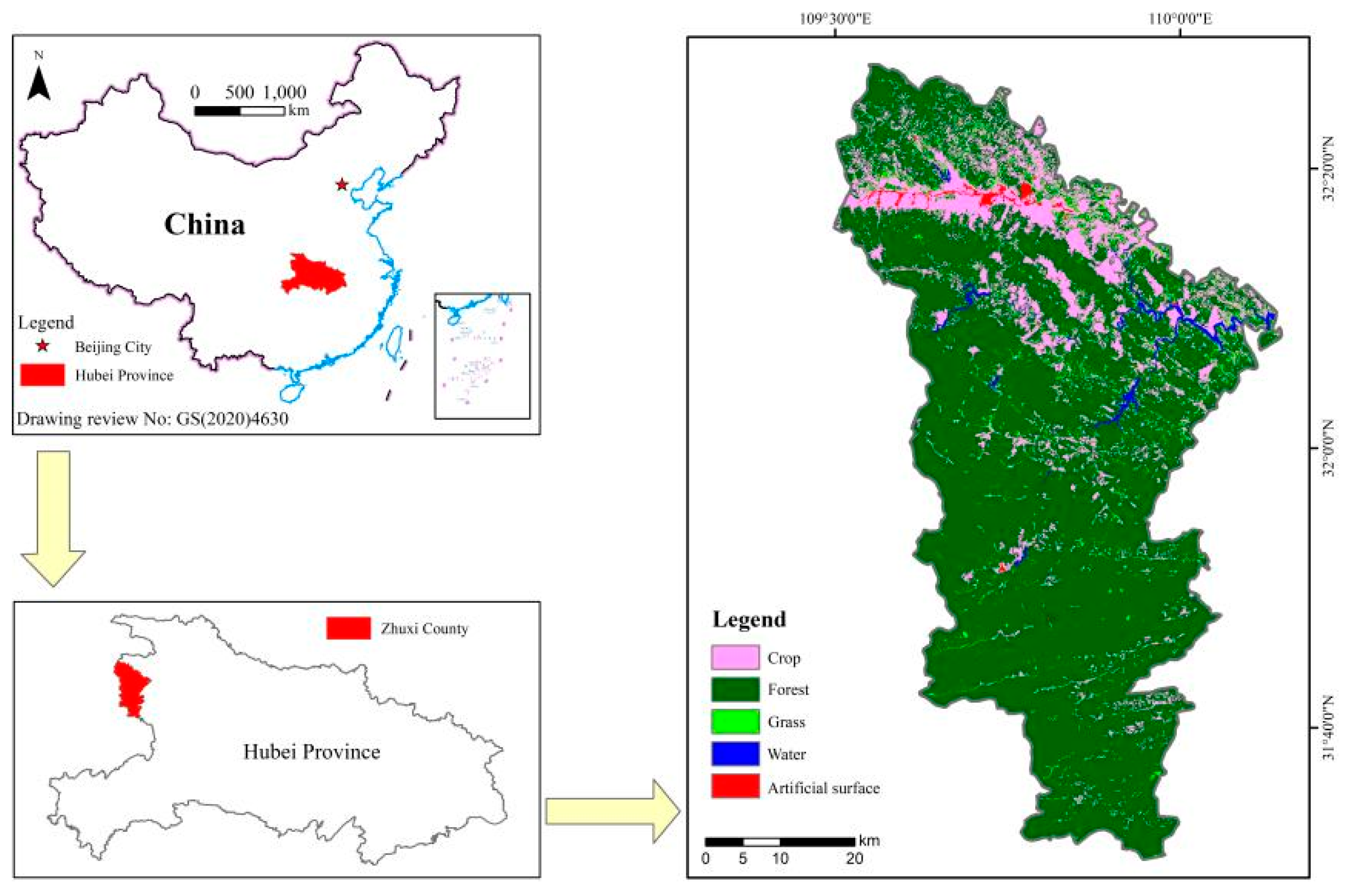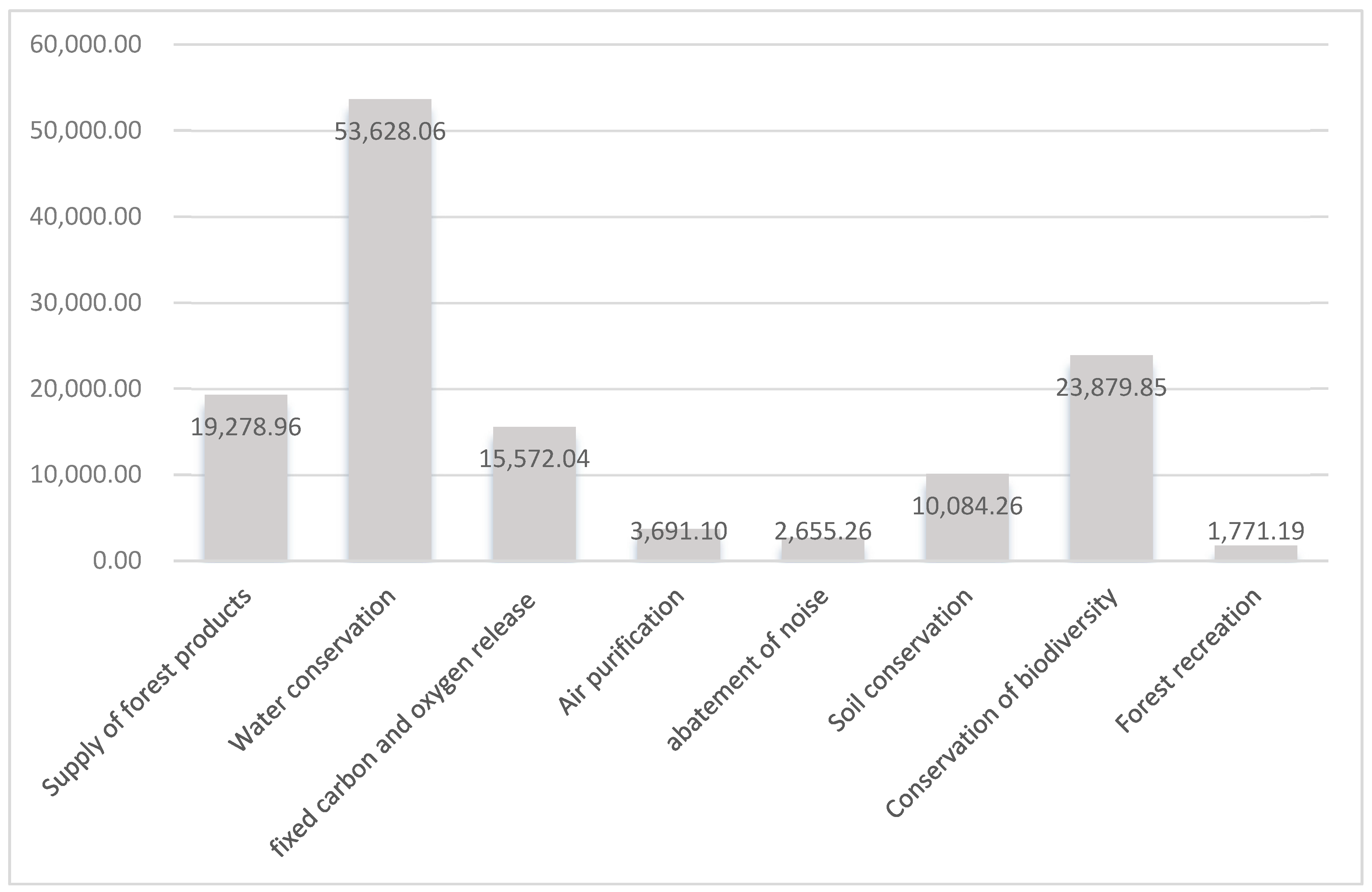4.1.1. Assessment Results for Forest Ecosystem Services Supply
After calculating the four categories and eight evaluation indicators of forest ecosystem services in Zhuxi County, it was concluded that the total supply value of forest ecosystem services in Zhuxi County in 2020. Sorted by size, adjustment services were the largest, support services were the second largest, supply services were the third largest, and cultural services were the smallest.
Table 9 presents the specific supply value assessment results.
The value of each forest ecosystem service in Zhuxi County and its proportion compared to the total value were as follows: supply of forest products 5,268,297,300 (14.77%); water conservation 14,654,761,700 (41.08%); carbon fixation and oxygen release 4,255,319,800 (11.93%); air purification 1,008,653,500 (2.83%); noise reduction 725,593,500 (2.03%); soil conservation 2,755,692,300 (7.72%); biodiversity conservation 6,525,568,200 (18.29%); and forest recreation 484,008,000 (1.36%). Among the eight indicators of forest ecosystem services in Zhuxi County, the value of water conservation was the largest, accounting for 41.08% of the total value, followed by the supply of forest products, accounting for 14.77% of the total value. The value of forest recreation was the smallest, accounting for only 1.36% of the total value.
According to the relevant data above, the forest ecosystem service value per unit area of Zhuxi County in 2020 was 130,560.73
. The specific value of the eight forest ecosystem services per unit area is shown in
Figure 2.
The values of forest ecosystem services per unit area are ranked as follows: water conservation 14,654,761,700 > biodiversity conservation 6,525,568,200 > forest recreation 484,008,000 > carbon fixation and oxygen release 4,255,319,800 > soil conservation 2,755,692,300 > air purification 1,008,653,500 > noise reduction 725,593,500 > forest recreation 484,008,000 . The value per unit area of forest ecosystem in Zhuxi County was the largest in terms of water conservation and the smallest in terms of forest recreation. This conclusion is more consistent with the findings of scholars regarding other cities around Zhuxi County, such as the Changzhutan region, where the forest ecosystem has the largest value in terms of water conservation and the smallest value in terms of forest recreation (Huang, 2010), and Nan County, Hunan Province, where the forest ecosystem has the greatest value in terms of water retention and the lowest value for forest recreation (Wu, 2015).
The values for the supply of forest products and forest recreation in Zhuxi County were calculated without distinguishing the species of trees, and the values were directly calculated and apportioned to each species according to its stand area. Therefore,
Table 9 does not list the value of each species in terms of the supply of forest products or forest recreation, both values being reflected in the total value of each species.
According to the calculation results, the magnitude and ranking of forest ecosystem service value per unit area of each forest stand in 2020 in Zhuxi County were as follows: broadleaf–mixed forest 140,658.65 > broadleaf forest 135,763.41 > coniferous–mixed forests 135,488.73 > mixed–coniferous forest 125,908.29 > cypress wood 122,976.80 > horsetail pine 109,544.90 > poplar 106,447.12 > economic forest 100,272.08 > bamboo forest 98,044.16 > shrubbery 94,196.70 > fir 89,181.32 .
The local broadleaf–mixed forest in Zhuxi County had the largest forest ecosystem service supply value, broadleaf forests were in the second place, and fir species had the smallest value. Different forest types have some differences in terms of the strength of their ecosystem service functions. Broadleaf–mixed forests ranked in the top two in terms of the value of carbon and oxygen release, noise reduction, soil conservation, and biodiversity, and were the first in terms of the value of supply services provided. The main supply services provided by broadleaf forests are soil conservation and biodiversity. Broadleaf forests have larger canopies and thicker diameters than other forest types, and they grow well locally, providing more value. Coniferous–mixed forests and the cypress wood category provide two main services, water conservation and atmospheric purification, while broadleaf–mixed forests are the best in noise reduction. The net stand productivity of bamboo forests is greater, so they have a higher function of carbon sequestration and oxygen release value but smaller values in other aspects. Fir forests have the highest stand height due to their tall and straight trees and are able to absorb large amounts of sulfur dioxide and dust, thus they have the strongest function in purifying the atmosphere. To improve the quality of local forest resources and their ecological service function value, thus improving the supply value of forest ecosystem service function per unit area, we can use mixed afforestation; adopt broadleaf–mixed or coniferous–mixed trees; choose high-quality species, such as fast-growing and vigorous species; and transform low-yielding and low-value species, such as bamboo forests and fir trees.
4.1.2. Forest Ecosystem Service Demand Assessment Results
According to the relevant data from 2020, the current demand value was calculated and analyzed for material, environmental, ecological security, and spiritual demand for forest ecosystem services in Zhuxi County.
The per capita demand for forest products in material demand met the standard value, indicating that the local production of wood products and nonwood products was sufficiently abundant to meet the demand of the local population. All indicators of environmental demand met the standard values, indicating that the services provided by forest ecosystems in Zhuxi County were sufficient to meet the needs of people in the living environment. Among the ecological security requirements, the soil and water conservation rate, the protection rate of ancient trees, and the rate of key biological species all reached the national standard values, indicating that the soil and water conservation capacity of the forest soil in Zhuxi County met the actual needs, and the species conservation capacity satisfied biological survival needs. The per capita scenic area in the spiritual demand category far exceeded the standard value, indicating that the forests of Zhuxi County provided enough scenic tourist sites to meet the demand of the local population for leisure tourism. The calculated data of the specific situation value in 2020 and the standard value are shown in
Table 10.
We calculated the demand for forest ecosystem services in Zhuxi County, compared the value of the index in 2020 with the standard value, identified the gaps in the index values and the standard values, and found that the forest area satisfies this index, and reached the standard value. The forest ecosystem can provide a variety of services for humans and simultaneously meet the human needs for raw materials, such as forest products, ecological environment quality, and leisure tourism. If the forest area required to meet the standard values of various indicators is directly summed, we would be counting the existing forest area twice.
Therefore, when determining the total forest area that can satisfy the various needs of people, the average of the area that can satisfy the demand evaluation indicators is taken as the forest area value and it is assumed that with this area, all the various demand evaluation indicators in this demand category can reach the standard value. After finding the forest area required for each demand category for forest ecosystem services, the arithmetic average of the area required for the four demand categories was found and then the total value of forest ecosystem services provided per unit area of forest was calculated by multiplying the demand area by the total value of forest ecosystem services provided per unit area of forest to obtain the total value of demand for forest ecosystem services in Zhuxi County, thereby realizing the mapping of demand value to supply value.
As per
Table 11, in 2020, the material demand as the per capita amount of forest products in Zhuxi County exceeded the standard value of demand. The Zhuxi County Forest could have met the local demand for forest products had its area been 176,926.39 ha. In 2020, environmental demand, water resources utilization, carbon compliance, air quality, and environmental noise conditions met or exceeded the standard value, so only 204,685.52 ha of forest area was needed to meet the environmental demand. For ecological security demand, maintaining the soil and water conservation rate to meet the standard required 241,916.88 ha of forest area and the protection rate of ancient trees and key biological species reached 100%, so the area requirement was not calculated. Therefore, 241,916.88 ha of forest area was needed to meet the ecological security requirement. In terms of the spiritual demand, since the scenic area of Zhuxi County in 2020 was 58,058.64 ha, the calculated landscape area per capita exceeded the standard value of per capita demand by several times. Thus, it can be concluded that only 45,448.24 ha of forest area was needed to meet the spiritual demands of the local people.
After determining the forest area needed for each demand type, direct summing would have led to the same problem of double counting. Therefore, the total demand for forest ecological services was taken as the average of the four demand types and the total demand area was calculated to be 176,926.39 hm2, which is much lower than the forest area that existed in Zhuxi County in 2020. From the aforementioned calculation, the value of forest ecosystem services per unit area in Zhuxi County was 130,560.73 . Thus, the total demand value of forest ecosystem services in Zhuxi County in 2020 was 23.10 billion , a value much smaller than the total supply value of 35.68 billion in 2020. The supply of forest ecosystem services in Zhuxi County was much larger than the demand and the supply of forest ecosystem services provided by forests in Zhuxi County was sufficient to meet local demand.








